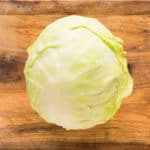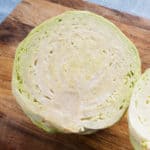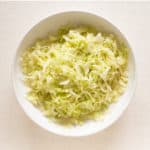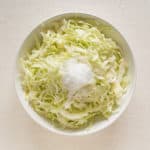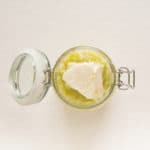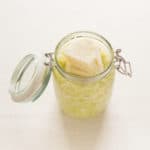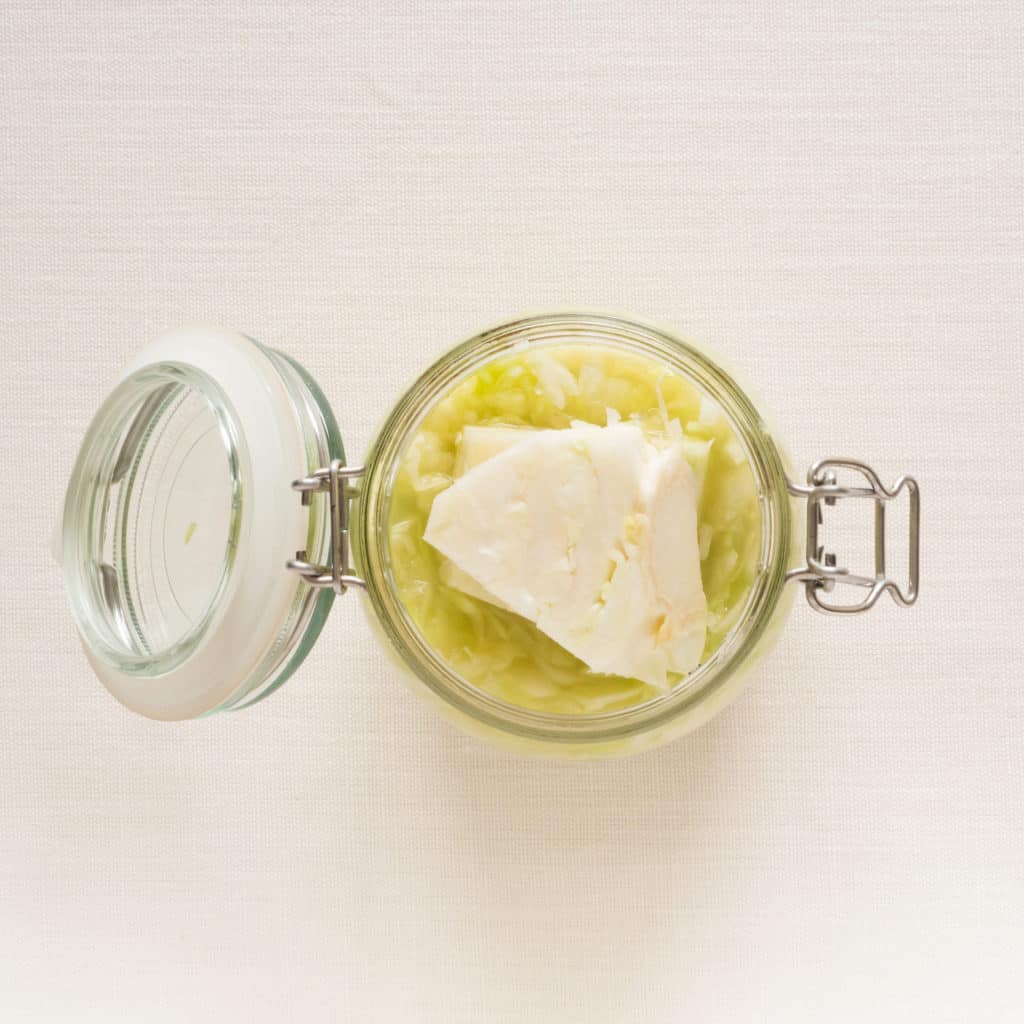
Sauerkraut love!!! Sauerkraut is all about the seasonal, the preserving, and ultimately, the taste. Sauerkraut is a lacto-fermented vegetable and has a wonderful taste that is hard to describe; tangy, umami, earthy, light and only slightly salty. Much underused, mocked and maligned Sauerkraut is great not only as an accompaniment or sandwich topper but as an ingredient in stir fries, stews and salads (especially if you don’t eat onions or garlic). It is a wonderful complex flavour that is so easy to create, at home and at low cost.
Sauerkraut quick and easy to make and will be ready to eat in as little as three days.
You will need wide necked, sterilised jars to ferment and store the Sauerkraut in.
You can find the full Sauerkraut recipe here.
Perfect on its own as a side, in sandwiches or as a surprise ingredient in almost any dish. Serve with Tofu and Green Peppers in Black Bean Sauce, Gluten Free, Vegan Quiche or add to Healthy, Gluten Free, Vegan, Ginger Tofu at step 5.
There are lots and lots of fermenting and pickle recipes around and you may well have a great, family recipe that works for you. I like this recipe for its simplicity of ingredients and method. If you want to know more about fermenting and preserving I can highly recommend The Art of Fermentation* by Sandor Ellix Katz. A wonderful book packed full of knowledge, passion and information (but not recipes as we know them). This book is my inspiration to try out different methods of preserving on the world of fruits and vegetables.
Most recipes use caraway seeds and/ or black peppercorns. Whilst I do love these ingredients I make this version as, without the caraway or pepper flavour, it is so versatile and can be used in almost any dish of any origin. It can be used in place of onion and garlic in stir fries and casseroles. However, you can add whatever spices you like – I am a big fan of hot chilli flakes!!!
You can apply this technique to almost any vegetable (darker greens tend to be more… pungent… perhaps an acquired taste). Root vegetables tend to ferment well (carrot and radishes in particular) and I adore preserved cauliflower. You can also add herbs and spices to your taste, dill, chillies etc. Experiment and see what works for you.
Top tip. Sterilise jars in the dishwasher and be careful when removing the jars from the dishwasher and handling them not to touch the inside of the jars to keep them sterile. You must make sure everything is scrupulously clean; utensils, chopping boards, hands and so on. Any dirt, soap or grease may inhibit the fermentation process.
Top tip. You will need to monitor the jars carefully, certainly over the first few weeks, as the fermentation begins, gas will be produced by the process so you will need to release the jars frequently (quite how often varies). Instead of sealing the jars you can use cloth, coffee filters etc. to keep out dust, flies, etc. and allow fermentation to continue without the possibility of exploding jars!!! Your choice.
Top tip. A word on salt. I use sea salt flakes which take up more volume than sea salt crystals and salt grains. This is why I measure salt by weight.
*Affiliate link.
Difficulty easy
Preparation time 20 minutes
Cooking time 0 minutes – waiting time to eat is as little as three days
You can find the full Sauerkraut recipe here.
Allergens
Sauerkraut is gluten-free and vegan as well as…
Celery free
Coconut free
Garlic free
Lupin free
Mustard free
Nightshade free
Onion free
Peanut free
Sesame free
Soya free
Tree nut free
What’s the Deal with Cabbage?
Cabbage is much maligned and mocked. It’s a vegetable I grew to love, very, very late in life. As a child I hated cooked vegetables. Raw veg I loved and would happily eat (almost) any vegetable raw. Cooked veg, when I was young, was perhaps better described as boiled, boiled until it was almost liquid. The 1970s can be summed up in two words, boiled and brown. Everything was boiled and brown (not just the food). However, once I turned vegetarian at 13, I was responsible for my own food and so I started my very long journey to liking cooked veg. This took another 20 years (less for some vegetables). I do not remember exactly when I learned to cook and love cabbage but I was in my 30s. Sauerkraut isn’t exactly cooked, more cured, but it was definitely part of the journey. Chinese and Vietnamese food helped rehabilitate cooked vegetables for me (with the exception of cooked carrot that is still totally wrong) with the quick and hot cooking method, that retains flavour, colour and texture. Now I adore (well) cooked cabbage.
The cabbage plant
Cabbage is the word used to describe several cultivars of Brassica oleracea. It’s a leafy green or purple biennial plant, grown as an annual vegetable crop for its dense-leaved heads. It’s descended from the wild cabbage and is closely related to broccoli, cauliflower, Brussels sprouts and savoy cabbage (sometimes referred to as brassicas or cole crops). Cabbage heads generally range from 0.5 to 4 kilograms in weight and can be green, purple or white. Smooth-leafed, firm-headed, green cabbages are most common, with smooth-leafed red and crinkle-leafed savoy cabbages of both colours seen less often. It is a multi-layered vegetable. Under conditions of long sunlit days such as are found at high northern latitudes in summer, cabbages can grow much larger. See many UK ‘massive veg’ competitions where there are prizes for the largest onion, carrot, cabbage, turnip etc.
Cabbage heads are generally picked during the first year of the plant’s life cycle, but plants intended for seed are allowed to grow a second year, and must be kept separated from other cole crops to prevent cross-pollination. Cabbage is prone to several nutrient deficiencies, as well as to multiple pests, and bacterial and fungal diseases.
Origins and spread of cabbage
Cabbage was most likely domesticated somewhere in Europe before 1000 BC, although savoys were not developed until the 16th century. By the Middle Ages, cabbage had become a prominent part of European cuisine.
It is difficult to trace the exact origins of cabbge owing to the many varieties of leafy greens classified as “brassicas”. The wild ancestor of cabbage, Brassica oleracea, originally found in Britain and continental Europe, is tolerant of salt but not encroachment by other plants and consequently inhabits rocky cliffs in cool damp coastal habitats,retaining water and nutrients in its slightly thickened, turgid leaves. resent one of three ancestral lines from which all other brassicas originated.[23]
Cabbage was probably domesticated later in history than near Eastern crops such as lentils and summer wheat. It is believed that multiple, broadly contemporaneous, domestication of cabbage occurred throughout Europe. Non-heading cabbages and kale were probably the first to be domesticated, before 1000 BC, by the Celts of central and western Europe.
What do you do with cabbage?
The characteristic flavor of cabbage is caused by glucosinolates, a class of sulphur-containing glucosides. Although found throughout the plant, these compounds are concentrated in the highest quantities in the seeds. Lesser quantities are found in young vegetative tissue, and they decrease as the tissue ages. The pungent, unpleasant odour and taste of (over) cooked cabbage is often referenced. These develop when cabbage is overcooked and hydrogen sulphide gas is produced.
Cabbages can be prepared in multiple ways ways for eating. They can be pickled, fermented for dishes such as sauerkraut, steamed, stewed, sautéed, braised, roasted or eaten raw.
The simplest (and often the best) ways to prepare cabbage are to eat the vegetable raw or steamed. Preserving, stewing, sautéing and braising are popular methods. Brining and fermenting creates dishes such as sauerkraut and kimchi. Savoy and spring cabbages are often used in salads. Bean curd and cabbage are staples of Chinese cooking, while the British dish bubble and squeak is made primarily with leftover potato and boiled cabbage and eaten with cold meat. In Poland, cabbage is one of the main food crops, and it features prominently in Polish cuisine. It is frequently eaten, either cooked or as sauerkraut, as a side dish or as an ingredient in such dishes as stews, stuffed cabbage) and pirogi. Other eastern European countries, such as Hungary and Romania, also have traditional dishes that feature cabbage as a main ingredient. In India and Ethiopia, cabbage is often included in spicy salads and braises.
Nutritional value of cabbage
Cabbage is a rich source of vitamin C and vitamin K, containing 44% and 72%, respectively, of the RDA per 100 grams of raw cabbage. Cabbage is also a moderate source (10–19% RDA) of vitamin B6 and folate, with no other nutrients having significant content per 100 gram serving.
What’s the Deal with Salt?
The consumption of salt is essential for humans. Too much salt is not good for you but, we all need salt in our diet. Without is there would be an electrolyte imbalance and serious and debiliating consequences. Most people have more than enough salt in their diet through processed food and drink. However, many people, often those who cook from scratch and do not routinely add salt to food and those who frequently exercise do not have enough salt in their diet.
Like vegetables, I came late to salt and the wonders of really, really good sea salt. I rarely eat processed foods, exercised hard and did not add much salt to my diet. I don’t think I got enough salt. However, what I did discover was fleur de sel, Maldon sea salt and all the other fabulous types of flaked sea salt. A truly wonderful taste, texture and addition to dishes.
What is salt?
Salt is essential to the health of humans and other animals, and is one of the five basic taste sensations.
Salt is, chemically speaking, sodium chloride (NaCl). A 1:1 ratio of sodium and chloride ions. With molar masses of 22.99 and 35.45 g·mol−1, respectively, 100 grams of NaCl contain 39.34 grams sodium and 60.66 grams chloride. Sodium chloride is the salt most responsible for the salinity of seawater and of the extracellular fluid of many multicellular organisms. In the form of edible or table salt it is commonly used as a condiment and food preservative. Large quantities of sodium chloride are used in many industrial processes, and it is a major source of sodium and chlorine compounds used as feedstocks for further chemical syntheses. A second major application of sodium chloride is de-icing of roads in sub-zero weather.
Sea salt is salt produced from the evaporation of seawater, rather than by being extracted from sedimentary deposits (like mineral salt). Salt is used in cooking and the chemical industry. Like mineral salt, production of sea salt has been dated to prehistoric times. However, there is little or no health benefit to using sea salt over other forms of sodium chloride salts.
Many microorganisms cannot live in an overly saline environment: water is drawn out of their cells by osmosis. For this reason salt has been used to preserve foods like cabbage.
Salt is added to food as a flavor enhancer, preservative, binder, fermentation-control additive, texture-control agent and colour developer.
Origins and spread of salt
Throughout history the availability of salt has been pivotal to civilisation. The word “salary” comes from the Latin word for salt because the Roman Legions were sometimes paid in salt. Before this, what is now thought to have been the first city in Europe, Solnitsata (which means “salt works”), in Bulgaria, was a salt mine, providing the area now known as the Balkans with salt since 5400 BC.
While people have used canning and artificial refrigeration to preserve food for the last hundred years or so, salt has been the best-known food preservative for many thousands of years.
There are basically two different types of salt: mineral salt and sea salt. Mineral salt is mined from the ground and sea salt is harvested from the sea. There is little chemical or nutritional difference between the two types. However, the difference is taste and texture between highly refined salt (e.g. table salt) and fleur de sel is enormous. Sea salt flakes have a different mouth feel, and may change flavor due to the different rate of dissolution. The mineral content also affects the taste.
The colours and variety of salt flavours are influenced by local geology and algae found in the waters the salt is harvested from. For example, some salts from Korea and France are pinkish grey, some from India are black. Black and red salts from Hawaii may even have powdered black lava and baked red clay added in.
Black lava salt is a marketing term for sea salt harvested from various places around the world that has been blended and coloured with activated charcoal. The salt is used as a decorative condiment to be shown at the table.
What do you do with salt?
Salt is used in almost every dish, in sweet and savoury food. Used sparingly and appropriately salt is a critical ingredient in many dishes. Over-used it will ruin a dish.
There are so many ways to used salt. As a primary ingredient it is used to brine or ferment vegetables and preserve them for use later in the season. As a seasoning salt should be used sparingly and thoughtfully.
Nutritional value of salt
Most of the sodium in the Western diet comes from salt. The habitual salt intake in many Western countries is about 10 grams per day, and it is higher than that in many countries in Eastern Europe and Asia. The high level of sodium in many processed foods has a major impact on the total amount consumed.In the United States, 75% of the sodium eaten comes from processed and restaurant foods, 11% from cooking and table use and the rest from what is found naturally in foodstuffs.
The World Health Organisation recommends that adults should consume less than 2000 milligrams of sodium (which is contained in 5 grams of salt) per day. Guidelines by the United States recommend that people with hypertension, African Americans, and middle-aged and older adults should limit consumption to no more than 1500 milligrams of sodium per day and meet the potassium recommendation of 4700 milligrams per day with a healthy diet of fruits and vegetables.
While reduction of sodium intake to less than 2300 milligrams per day is recommended by developed countries,3] one review recommended that sodium intake be reduced to at least 1200 milligrams (contained in 3 grams of salt) per day, as a further reduction in salt intake the greater the fall in systolic blood pressure for all age groups and ethnicity. Another review indicated that there is inconsistent/ insufficient evidence to conclude that reducing sodium intake to lower than 2300 milligrams per day is either beneficial or harmful.
